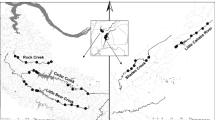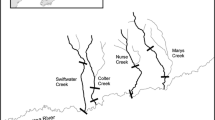Abstract
Surveys of horseshoe crab juvenile distribution and abundance typically do not include shallow subtidal areas primarily because of the logistical difficulties with sampling in this habitat. A suction-dredge was constructed consisting of a “T”-shaped sampling head; an 8-hp trash pump, a 15.2-m-long non-collapsible hose-pipe; and a gunwale-mounted catch-basin to survey newly hatched juvenile horseshoe crabs in shallow subtidal habitats of lower Delaware Bay. Suction-dredge data were compared to catches taken in 4.9-m-small trawl collections at a series of 84 shallow water stations in 4 separate sampling events conducted in the summer and fall of 2004. Suction-dredge sampling for standard tow lengths of 15.2 m produced orders of magnitude higher catches compared to the trawls which were towed for an average of 109 m. The dredge was capable of sampling many stations in a single day and did not damage juveniles excessively. There was evidence for gradual bayward migrations of juvenile horseshoe crabs, as higher densities were found close to the spawning beaches in July, but progressively higher densities were found in offshore transects in August. Few juveniles were collected in September and October. This study demonstrated that juvenile horseshoe crabs were abundant in shallow subtidal areas of Delaware Bay, and that suction-dredge sampling could provide a valuable tool to monitor horseshoe crab populations.
Access this chapter
Tax calculation will be finalised at checkout
Purchases are for personal use only
Similar content being viewed by others
References
Almendral MA, Schoppe S (2005) Population structure of Tachypleus tridentatus (Chelicerata: Merostomata) at a nursery beach in Puerto Princesa City, Palawan, Philippines. J Nat Hist 39: 2319–2329
ASMFC (Atlantic States Marine Fisheries Commission). (1998) Interstate fishery management plan for horseshoe crab. Fishery Management Report No. 32, 58 p. ASMFC, 1444 Eye Street, NW, Sixth Floor, Washington, DC 2005.
Botton M, Ropes J (1987) Populations of horseshoe crabs, Limulus polyphemus, on the northwestern Atlantic continental shelf. Fish Bull 85:805–812
Carmichael RH, Rutecki D, Valiela I (2003) Abundance and population structure of the Atlantic horseshoe crab, Limulus polyphemus, in Pleasant Bay, Cape Cod. Mar Ecol Prog Ser 246:225–239
Hata D, Berkson JM (2003) Abundance of horseshoe crabs, Limulus polyphemus, in the Delaware Bay area. Fish Bull 101(4):933–938
Hong RF (2004) Population and distribution of horseshoe crab Carcinoscorpius rotundicauda at the Kranji Nature Trail estuaries, Western Johor Straits. Singapore: The National University of Singapore, Department of Biological Sciences, Project report, 49.
Rudloe A (1981) Aspects of the biology of juvenile horseshoe crabs, Limulus polyphemus. Bull Mar Sci 31:125–133
Shuster CN Jr, Botton ML (1985) A contribution to the population of horseshoe crabs, Limulus polyphemus (L.), in Delaware Bay. Estuaries 8: 63–372
Shuster CN Jr (1982) A pictorial review of the natural history and ecology of the horseshoe crab, Limulus polyphemus, with reference to other Limulidae. In Bonaventura J, Bonaventura C, Tesh S (eds) Physiology and Biology of Horseshoe Crabs. Alan R. Liss, New York, pp 1–52
Smith DR, Pooler PS, Swan BL, Michels S, Hall WR, Himchak P, Millard M (2002) Spatial and temporal distribution of horseshoe crab (Limulus polyphemus) spawning in Delaware Bay: implications for monitoring. Estuaries 25:115–125
Walls EA, Berkson JM, Smith SA (2002) The horseshoe crab, Limulus polyphemus: 200 million years of existence, 100 years of study. Rev Fish Sci 10:39–73
Author information
Authors and Affiliations
Corresponding author
Editor information
Editors and Affiliations
Rights and permissions
Copyright information
© 2009 Springer Science+Business Media, LLC
About this chapter
Cite this chapter
Burton, W.H., Kelley, F.S., Franks, E.A. (2009). Distribution of Juvenile Horseshoe Crabs in Subtidal Habitats of Delaware Bay Using a Suction-Dredge Sampling Device. In: Tanacredi, J., Botton, M., Smith, D. (eds) Biology and Conservation of Horseshoe Crabs. Springer, Boston, MA. https://doi.org/10.1007/978-0-387-89959-6_18
Download citation
DOI: https://doi.org/10.1007/978-0-387-89959-6_18
Published:
Publisher Name: Springer, Boston, MA
Print ISBN: 978-0-387-89958-9
Online ISBN: 978-0-387-89959-6
eBook Packages: Biomedical and Life SciencesBiomedical and Life Sciences (R0)




